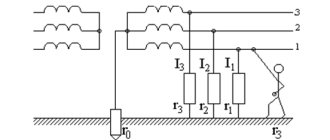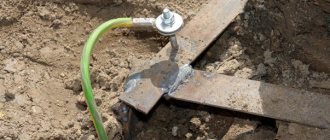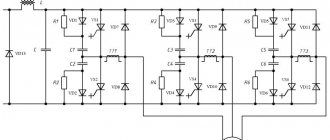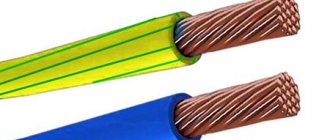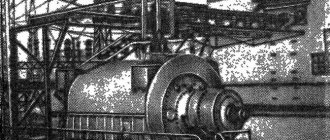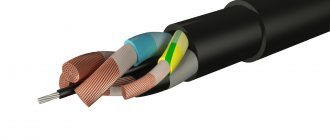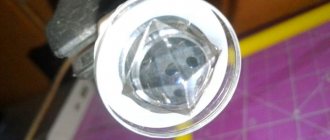Protective grounding is a system designed to prevent the effects of electric current on a person by deliberately connecting the housing and non-current-carrying parts of equipment that may be energized to ground. Grounding systems can be natural or artificial.
What should the grounding conductor be like?
The structure of the wire intended for grounding is necessarily copper. In domestic conditions, two types are used, single-wire and multi-wire. The size of the grounding wire is determined depending on the requirements of your home network. We invite you to explore the options for conductors that are ideal for playing the role of connecting to a grounding device.
The brand of cable for “ground” is selected taking into account the type of grounding already installed. It can act as stationary and non-stationary. Stationary or non-portable grounding is used for large buildings, for example, in production or at home. For these cases, it is recommended to use NYM brand wires.
In some cases, a cheaper brand of PPV is also used. It is advisable to choose three-core conductors for residential grounding or mobile devices from the brands VVG, PVG and ESUY. Let's look at the characteristics of the cables of each proposed brand.
Location in the ground
Artificial grounding is used where it is not possible to use natural grounding, or when the current loads on natural grounding conductors exceed permissible limits. Artificial grounding devices are made of steel structures, but if the soil is too acidic, or, on the contrary, it is susceptible to alkalization, grounding devices made of copper or galvanized metal are used.
The shape and structure of the artificial ground electrode is similar to a classic electrode. More often, this is a rod made of a steel strip or a round rod. Based on the type of location, there are 2 main types of memory. In the horizontal type, grounding conductors are laid along the perimeter of the foundation at the bottom of the trench.
Vertical grounding conductors are made from rods with a diameter of 12-15 mm and a length of up to 4-5 meters. They are driven into the ground to a depth of 0.5-0.7 m.
The placement of artificial grounding conductors at a certain angle is allowed, and then the concepts of vertical or horizontal become conditional.
An inclined arrangement is used if the wall of the building is located at an angle to the vertical. Tilt does not significantly affect the functions of the device.
In grounding electrical installations with high voltage, so-called complex grounding conductors are used, in which vertical elements are connected to horizontal ones.
When the device of artificial ground electrodes is placed on arable land, all electrodes must be placed at a depth of at least 1 meter. This allows for increased contact with the ground.
Corrosion protection
Since the steel strip for grounding will be in continuous contact with moisture and soil, that is, in an unfavorable environment, measures are taken to protect the steel from corrosion to prevent premature failure. Since it is not possible to apply a protective layer of paint in this case due to the fact that it will act as an insulator, preliminary galvanizing of the strip is used. Strips made of copper can also be used, which in its conductive characteristics exceeds steel, but due to the high cost and complexity of welding, they are used much less frequently.
Galvanizing in this case turns out to be the “golden mean”: on the one hand, it offers truly reliable protection, especially in the absence of mechanical stress, and on the other hand, it turns out to be a fairly cheap and practical method.
Resistance of artificial ground electrode
In order for the charger to effectively perform its task, it must have a spreading resistance that does not exceed certain values. This parameter shows how well the device conducts electric current.
For a grounded electrical installation with a voltage of 380V, the resistance of the artificial ground electrode should not exceed 30 Ohms. Operating under high voltage, medical equipment, server units, video surveillance systems are grounded with a resistance of 0.5-1 Ohm.
Calculation for artificial grounding conductors is carried out in order to determine how many vertical and horizontal conductive rods should be installed to obtain optimal resistance.
Grounding conductor color: PUE conditions
Each cable consists of internal cores, which have their own meaning and a specific color. Thanks to the existing palette, it is easy to carry out repair and installation work. Painting the core insulation will help you avoid the most unexpected mistakes. Let us turn to the rules established by state regulations:
In addition to the color designation, the grounding wire must also have a letter marking (PE-neutral conductor). Sometimes three-wire wiring in a house is made of flat, single-color conductors; most often they are presented in white. In this case, the middle core is used as grounding.
Important! With the help of colored wiring, it is easy to determine the function of the conductors without using computing instruments.
Some manufacturers paint the insulating layer of the grounding conductor green or yellow. Sometimes the yellow-green color is applied transversely. If you repaired the electrical wiring yourself, you will have to apply the desired color to the wiring yourself, so as not to confuse phase, neutral and ground in the future. For such purposes, silicone tubes of the appropriate color are used. They are available for sale in specialized stores. We suggest watching a video that shows detailed installation of the grounding cable and immediately make sure that it is the correct shade.
Source
What is grounding and why is it needed?
Grounding devices are a deliberate connection of various points of the electrical network by electrical conductors.
The purpose of grounding is to prevent exposure to electric current to a person. Another purpose of protective grounding is to remove voltage from the electrical installation body through a grounding device to the ground.
The main purpose of using grounding is to reduce the potential level between the point that is grounded and the ground. This reduces the current strength to the lowest level and reduces the number of damaging factors in contact with parts of electrical appliances and installations in which a breakdown has occurred on the housing.
Corrosion protection
Since the steel strip for grounding will be in continuous contact with moisture and soil, that is, in an unfavorable environment, measures are taken to protect the steel from corrosion to prevent premature failure. Since it is not possible to apply a protective layer of paint in this case due to the fact that it will act as an insulator, preliminary galvanizing of the strip is used. Strips made of copper can also be used, which in its conductive characteristics exceeds steel, but due to the high cost and complexity of welding, they are used much less frequently.
Galvanizing in this case turns out to be the “golden mean”: on the one hand, it offers truly reliable protection, especially in the absence of mechanical stress, and on the other hand, it turns out to be a fairly cheap and practical method.
What should the grounding conductor be like?
The structure of the wire intended for grounding is necessarily copper.
In domestic conditions, two types are used, single-wire and multi-wire. The size of the grounding wire is determined depending on the requirements of your home network. We invite you to explore the options for conductors that are ideal for playing the role of connecting to a grounding device. The brand of cable for “ground” is selected taking into account the type of grounding already installed. It can act as stationary and non-stationary. Stationary or non-portable grounding is used for large buildings, for example, in production or at home. For these cases, it is recommended to use NYM brand wires.
In some cases, a cheaper brand of PPV is also used. It is advisable to choose three-core conductors for residential grounding or mobile devices from the brands VVG, PVG and ESUY. Let's look at the characteristics of the cables of each proposed brand.

